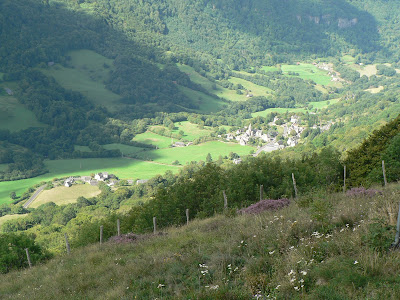We have moved to the mountains. Our choice this morning was between the route for lentils (via du Puys) and the route for cheeses (via the Cantral mountains). The cheese route won – though it was a close call, and we all want to come back sometime soon to do the lentil route. Mayhap next year.
All day we have been spiralling the high country of the Massif Central – land so high we have seen no caravans and only two other motorhomes enroute. Our little camping car has us dizzy keeping up with it on the circuitous mountain tracks that, in some cases, are only wide enough for a brace of motorbikes.
We are taking the Route du Fromage, avoiding small herds of fat brown and white milking cows wandering after lush green grasses, who have chosen the sensible option of wearing bells, so these hills are alive with the soft tinkle of their cowbells. The scenery, too, is lifted flawlessly from the Sound of Music overture.
We stop enroute at the beautiful little Romanesque churches of Saint Saturnin and Saint Nectaire. It is Sunday, so this is totally appropriate, and as we walk the delightfully archaic and authentic streets of St Saturnin we smell Sunday lunch cooking in every historic little townhouse, hidden behind medieval gates and teeny doors. Everywhere, we hear and see families gathering, indoors and out, for the expansive Sunday repasts. We pass their well kept gardens: fat tomatoes, cucumbers and beans, still ripe on the vines, herbs, root vegetables, flowers. There is no need to go to a store in these parts. Self reliance – and fresh organic products – are so valued.
At Saint Nectaire we have our lunch in the centre ville parked in front of its perfectly kept church. The cure has violin solo pieces playing softly and is advertising a duet concert tomorrow in the evening. I would love to be here then. The acoustics are superb, as is the perfect little church with its amazing capitols in the nave and choir. One hundred and three of them, typifying the miracles Saint Nectaire performed to gain sainthood. Though I see, from the musee, that Saint Nectaire’s gloved armour is missing a finger or two: probably in battle: I pat his head soothingly, as we leave. Such a lovely place.
Visiting all these saints has Peter’s brain in gear. He has decided, after much deliberation, but particularly after Lourdes and yesterday’s visit to Saint Bernadette’s chaisse, that Bec must move into the market of doing saintly deeds. That way he can become rich. All he has to do, he says, is to market her miracles, and the hoards will come running, throwing their many coins at Saint Rebecca. He has been coaching her all day.
For lunch we eat from a round of the world famous Saint Nectaire cheese: it is soft, nutty, and salivatingly moreish, and it comes from the buttery cows tinkling enroute. Who needs nectar? Oh, cry, Will Stubbs, cry!
As we drive higher we notice tiny stone huts, built into the sides of barren rock scarred hills. These with sloping roofs daubed and sodden with a mix of earth, dung and grass. These are the burons where, not so long ago, lone cowherders, al la Brokeback Mountain, would stay for the entire season, minding herds of Cantal cattle: guarding them, sleeping lightly, gathering firewood, boiling and sterilizing the cheesecloths, filtering the collected milk, pressing the separated curd, draining the liquid whey, storing and turning the ronds of cheese that they then stacked against the walls of the burons, well cooled from the midday sun.
After more dizzying heights, and as the sun sets over this bucolic setting, we head to our campsite: a large pond, edged with purple wildflowers, a cascading spring to one side, where an old man is fishing with a soft floaty red fly flashing in the sun, and a noisy cow in the field behind with the bell around his neck pitched to high volume.






















